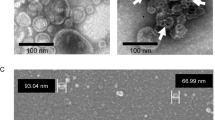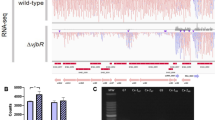Summary
The regulation of mouse bacteremia genes (mba genes) encoded by a 6.4 kb region on the 50 kb virulence plasmid (pKDSC50) of Salmonella serovar Choleraesuis was analyzed. The genes mba1, mba2, mba3, and mba4, are arranged in this order, and form a cluster located in the 6.4 kb mba region. We prepared four antibodies, each specific for an individual Mba protein, using synthetic peptides as antigens. Their amino acid sequences were deduced from the DNA sequence of the corresponding mba genes. Each Mba peptide antiserum was able to recognize the corresponding Mba protein produced by Escherichia coli carrying a recombinant plasmid containing individual mba genes. When the recombinant plasmid contained all four mba genes (pMKD601), three Mba proteins (Mba2, Mba3, and Mba4) were identified by Western blotting analysis using Mba antisera. These proteins could not be detected when the recombinant plasmid lacked mba1 (pMKD201). Three species of mRNA for mba2, mba3, and mba4 with different chain length were detected from pMKD601 by Northern blot hybridization, and two start sites were identified by primer extension assay. Gel mobility shift assays demonstrated that Mbal specifically bound to a fragment containing the start sites of mRNAs. The amino acid sequence of Mbal had significant homology to the LysR family of DNA binding proteins, possessing a characteristic helix-turn-helix DNA binding motif. The present study provides clear evidence to show that the Mba1 protein binds to the promoter region of mba2, and positively regulates the expression of mba2, mba3, and mba4 genes.
Similar content being viewed by others
References
Baird GD, Manning EJ, Jones PW (1985) Evidence for related virulence sequences in plasmids of Salmonella dublin and Salmonella typhimurium. J Gen Microbiol 131:1815–1823
Barrow PA, Lovell MA (1988) The association between a large molecular mass plasmid and virulence in a strain of Salmonella pullorum. J Gen Microbiol 134:2307–2316
Barrow PA, Simpson JM, Lovell MA, Binns MM (1987) Contribution of Salmonella gallinarum large plasmid toward virulence in fowl typhoid. Infect Immun 55:388–392
Beninger PR, Chikami G, Tanabe K, Roudier C, Fierer J, Guiney DG (1983) Physical and genetic mapping of the Salmonella dublin virulence plasmid pSDL2. J Clin Invest 81:1341–1347
Caldwell AL, Gulig PA (1991) The Salmonella typhimurium virulence plasmid encodes a positive regulator of a plasmidencoded virulence gene. J Bacteriol 173:7176–7185
Fang FC, Krause M, Roudier C, Fierer J, Guiney DG (1991) Growth regulation of a Salmonella plasmid gene essential for virulence. J Bacteriol 173:6783–6789
Gulig PA (1990) Virulence plasmids of and other Salmonellae. Microb Pathogen 8:3–11
Gulig PA, Curtiss R III (1988) Cloning and transposon insertion mutagenesis of virulence genes of the 100-kilobase plasmid of Salmonella typhimurium. Infect Immun 56:3262–3271
Helmuth R, Stephan R, Bunge C, Hoog CBB, Steinbeck A, Bulling E (1985) Epidemiology of virulence-associated plasmids and outer membrane protein patterns within seven Salmonella serotypes. Infect Immun 48:175–182
Henikoff S, Haughn GW, Calvo JM, Wallace JC (1988) A large family of bacterial activator proteins. Proc Natl Acad Sci USA 85:6602–6606
Hopp TP, Woods KR (1981) Prediction of protein antigenic determinants from amino acid sequences. Proc Natl Acad Sci USA 78:3824–3828
Jones GW, Rabert DK, Svinarich DM, Whitfield HJ (1982) Association of adhesive, invasive, and virulent phenotypes of Salmonella typhimurium with autonomous 60-megadalton plasmids. Infect Immun 38:476–486
Kawahara K, Haraguchi Y, Tsuchimoto M, Terakado N, Danbara H (1988) Evidence of correlation between 50-kilobase plasmid of Salmonella choleraesuis and its virulence. Microb Pathogen 4:155–163
Kawahara K, Tsuchimoto M, Sudo K, Terakado N, Danbara H (1990) Identification and mapping of mba regions of the Salmonella choleraesuis virulence plasmid pKDSC50 responsible for mouse bacteremia. Microb Pathogen 8:13–21
Krause M, Roudier C, Fierer J, Harwood J, Guiney D (1991) Molecular analysis of the virulence locus of the Salmonella dublin plasmid pSDL2. Mol Microbiol 5:307–16
Lehrach H, Diamond D, Wozney JM, Boedtker H (1977) RNA molecular weight determination by gel electrophoresis under denaturing conditions, a critical reexamination. Biochemistry 16:4743–4751
Lowry OH, Rosebrough NJ, Farr AL, Randall RJ (1951) Protein measurement with the Folin phenol reagent. J Biol Chem 193:265–275
Manning EJ, Baird GD, Jones PW (1986) The role of plasmid genes in the pathogenicity of Salmonella dublin. J Med Microbiol 21:239–243
Matsui H, Kawahara K, Terakado N, Danbara H (1990a) Nucleotide sequence of a gene encoding a 29 kDa polypeptide in mba region of the virulence plasmid, pKDSC50, of Salmonella choleraesuis. Nucleic Acids Res 18:1055
Matsui H, Kawahara K, Terakado N, Danbara H (1990b) Nucleotide sequences of genes encoding 32 kDa and 70 kDa polypeptides in mba region of the virulence plasmid, pKDSC50, of Salmonella choleraesuis. Nucleic Acids Res 18:2181–2182
Matsui H, Abe A, Kawahara K, Terakado N, Danbara H (1991) Positive regulator for the expression of Mba protein of the virulence plasmid, pKDSC50, of Salmonella choleraesuis. Microb Pathogen 10:459–464
McKnight SL, Kingsbury R (1982) Transcriptional control signals of a eukaryotic protein-coding gene. Science 217:316–324
Mekalanos JJ (1992) Environmental signals controlling expression of virulence determinants in bacteria. J Bacteriol 174:l-7
Melton DA, Krieg PA, Rebagliati MR, Maniatis T, Zinn K, Green MR (1984) Efficient in vitro synthesis of biologically active RNA and RNA hybridization probes from plasmids containing a bacteriophage SP6 promoter. Nucleic Acids Res 12:7035–7056
Nakamura M, Sato S, Ohya T, Suzuki S, Ikeda S (1985) Possible relationship of a 36-megadalton Salmonella enteritidis plasmid to virulence to mice. Infect Immun 47:831–833
Norel F, Coynault C, Miras I, Hermat D, Popoff MY (1989) Cloning and expression of plasmid DNA sequences involved in Salmonelta serotype Typhimurium virulence. Mol Microbiol 3:733–743
Otter R, Cozzarelli NR (1983) Escherichia coli DNA gyrase. Methods Enzymol 100:171–180
Rhen M, Virtanen M, Makela PH (1989) Localization by insertion mutagenesis of a virulence-associated region on the Salmonella typhimurium 96 kilobase pair plasmid. Microb Pathogen 6:153–158
Sanger F, Nicklen S, Coulson AR (1977) DNA sequencing with chain-terminating inhibitors. Proc Natl Acad Sci USA 74:5463–5467
Taira S, Rhen M (1989a) Identification and genetic analysis of mkaA — a gene of the Salmonella typhimurium virulence plasmid necessary for intracellular growth. Microb Pathogen 7:165–173
Taira S, Rhen M (1989b) Molecular organization of genes constituting the virulence determinant of the Salmonella typhimurium 96 kilobase pair plasmid. FEBS Lett 257:274–278
Taira S, Rhen M (1990) Nucleotide sequence of mkaD, a virulenceassociated gene of Salmonella typhimurium containing variable and constant regions. Gene 93:147–150
Taira S, Baumann M, Riikonen P, Sukupolvi S, Rhen M (1991a) Amino-terminal sequence analysis of four plasmid-encoded virulence-associated proteins of Salmonella typhimurium. FEMS Microbiol Lett 77:319–324
Taira S, Riikonen P, Saarilahti H, Sukupolvi S, Rhen M (1991b) The mkaC virulence gene of the Salmonella serovar Typhimurium 96 kb plasmid encodes a transcriptional activator. Mol Gen Genet 228:381–384
Terakado N, Sekizaki T, Hashimoto K, Naito S (1983) Correlation between the presence of a fifty-megadalton plasmid in Salmonella dublin and virulence for mice. Infect Immun 41:443–444
Tullis RH, Rubin H (1980) Calcium protects DNase I from proteinase K: a new method for the removal of contaminating RNase from DNase I. Anal Biochem 107:260–264
Urbanowski ML, Stauffer GV (1989) Genetic and biochemical analysis of the MetR activator-binding site in the metE metR control region of Salmonella typhimurium. J Bacteriol 171:5620–5629
Vieira J, Messing J (1987) Production of single-strand plasmid DNA. Methods Enzymol 153:3–11
Yanisch-Perron C, Vieira J, Messing J (1985) Improved M13 cloning vectors and host strains: nucleotide sequences of the M13mpl8 pUC19 vectors. Gene 33:103–109
Author information
Authors and Affiliations
Additional information
Communicated by K. Isono
Rights and permissions
About this article
Cite this article
Matsui, H., Abe, A., Suzuki, S. et al. Molecular mechanism of the regulation of expression of plasmid-encoded mouse bacteremia (mba) genes in Salmonella serovar Choleraesuis. Molec. Gen. Genet. 236, 219–226 (1993). https://doi.org/10.1007/BF00277116
Received:
Accepted:
Issue Date:
DOI: https://doi.org/10.1007/BF00277116




